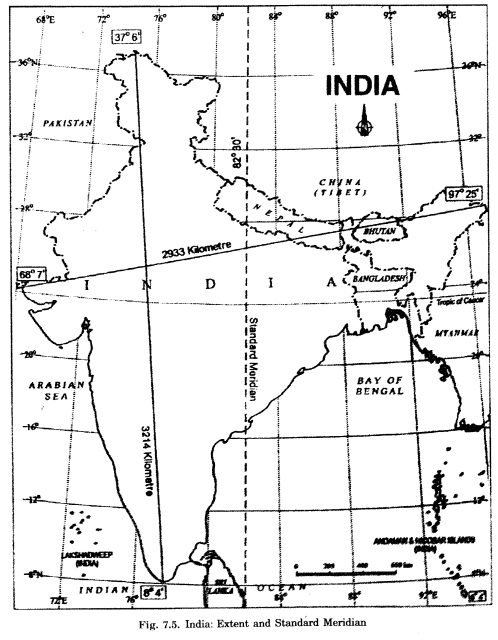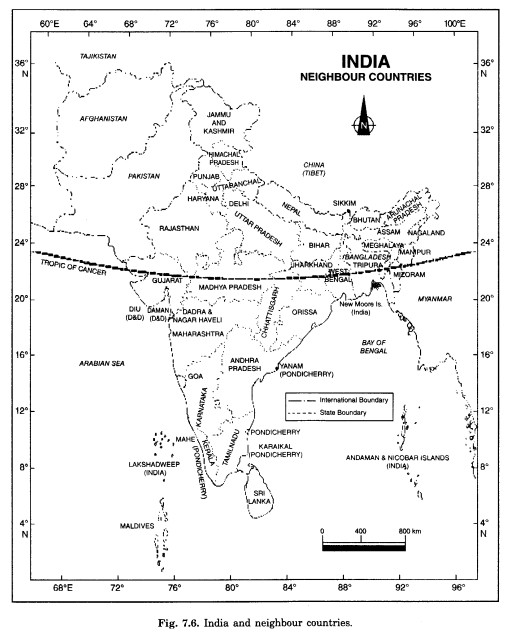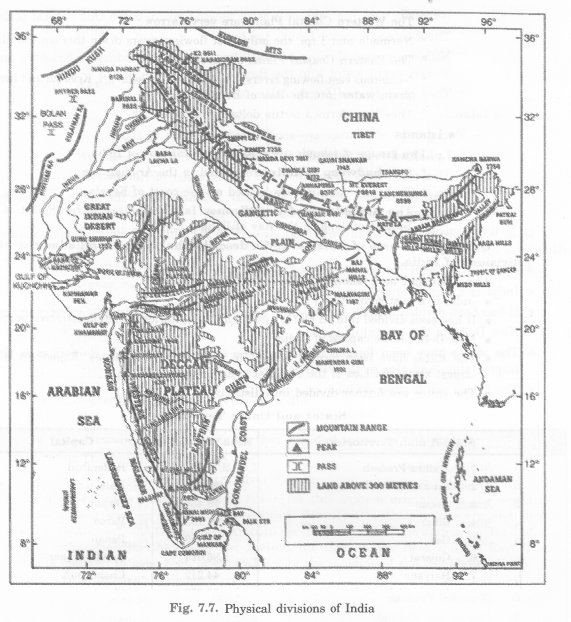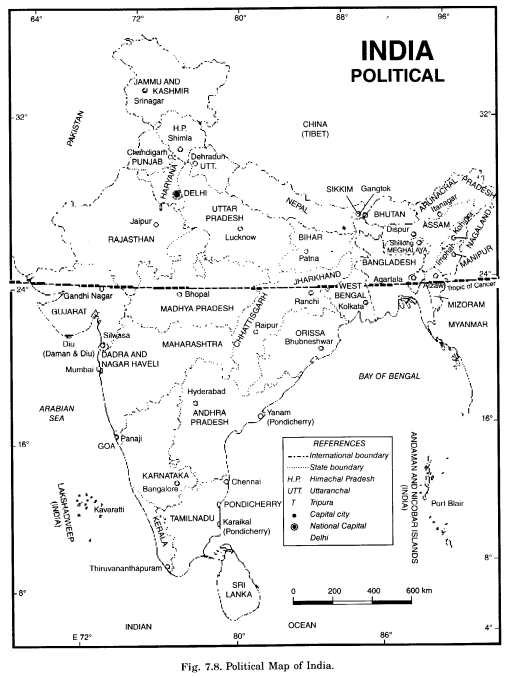Our Country India Class 6 Extra Questions Social Science Geography Chapter 7
NCERT Extra Questions for Class 6 Social Science Geography Chapter 7 Our Country India
Our Country India Class 6 Extra Questions Very Short Answer Type
- Coral are tiny marine animals. They are called polyps.
- When the living polyps die their skeletons are left. Other polyps grow on top of the hardened skeleton which grow higher and higher in course of time. Thus coral islands are formed.
Our Country India Class 6 Extra Questions Short Answer Type
- India is a country of vast geographical expanse.
- It is bounded by the mighty Himalayas in the north.
- Arabian sea bounds it in the west.
- Bay of Bengal forms its boundary in the east.
- Indian ocean bounds it in the south.
- India has an area of about 32.8 crore hectares.
- Its north-south extent from Kashmir to Kanyakumari is about 3200 kms.
- It extends east-west from Arunachal Pradesh to Kuchchh over 2900 kms.
- The lofty mountains, the Thar desert, the Northern plains, Peninsular Plateau, east and west coasts and islands present a diversity of land forms.
- There is a great variety in climate, vegetation, wildlife as well as language and culture in India.
- In this diversity there is unity. It is reflected in traditions that bind us as one nation.
- India has a population of 122 crore according to Census of 2011.
- It is the second most populous country of the world after China.
- The Himalayan Mountains
- The North Indian Plains
- The Pennisular Plateau
- The Islands
- The Coastal Plains.

| The Western Ghats | The Eastern Ghats |
| 1. The western edge of the Peninsular plateau is called the western ghats. | 1. The eastern edge of the Peninsular plateau is called eastern ghats. |
| 2. They are continuous. | 2. They are discontinuous as they are broken at places. |
| 3. They consist of Sahyadri, the Nilgiri, the Annamalai and the Cardamom hills. | 3. They consist of Mahendra Giri and Malaya Giri ranges. |
| 4. Their height ranges between 1000 and 1600 metre from mean sea level. | 4. Their height is 300 to 900 metres from mean sea level. |
- India is located in the Northern hemisphere in respect of latitudes and the Eastern hemisphere in respect of longitudes.
- Tropic of Cancer (23°30′ N) passes almost through the middle of the country.
- From South to North, India is located between 6°4′ N latitudes and 37°6′ N latitudes.
- From West to East, India extends between 68°7′ E and 97°25′ E longitudes.
Effect of East-West extent on Time:
- The west to east extent leads to difference in local time from meridian to meridian.
- The local time changes by 4 minutes for every 1° difference in longitude (meridian).
- The time difference between the two extreme west and east points (Gujarat and Arunachal Pradesh) of India is about 2 hours.
- The sun rises 2 hours earlier in the east than in the west.
- The local time of 82°30′ E longitude is taken as the Indian Standard Time.
- This longitude is known as the Standard Meridian of India.
- Its time is taken as standard throughout the country.
- All watches in the country run according to the time of this meridian.
- Its time is called as 1ST.
- India’s neighbours are those countries which have common boundaries with India.
- There are seven countries which have common land boundaries with India.
- They are Pakistan, Afghanistan, Nepal, Bhutan, Myanmar, Bangladesh and China.
- In the Indian Ocean our island neighbours-Sri Lanka and Maldives lie.
- Sri Lanka is separated from India by the Palk Strait.

Our Country India Class 6 Extra Questions Long Answer Type
- The Himalayas stands as sentinels in the North.
- They are the lofty snow capped Himalayas.
- Himalaya means ‘the Abode of Snow’.
The Himalayan mountains are divided into three main parallel ranges.
- The northernmost is the Great Himalayas or Himadri. The world’s highest peaks like Mt. Everest, Kanchanjunga are located in this range.
- Middle Himalayas or Himachal lies to the South of Himadri. Numerous popular hill stations are situated here. Mussorie, Chakrata, Dharmashala, Kullu and Manali are important hill stations.
- The Shiwaliks are the southernmost range of the Himalayas. It has several longitudinal valleys called ‘dunes’. Dehradun, Kotharidun, Patlidun are some examples of these valleys.
- The Northern Indian plains lie to the south of the Himalayas.
- They are generally plain and flat.
- Alluvial deposits laid down by the rivers have formed these plains.
- Ganga, Brahmaputra and their tributaries flow through these plains.
- They provide fertile land for cultivation. Hence high density of population is found in the plains.
Thar desert lies in the western part of India. It is a dry, hot and sandy stretch of land.
- It has very little vegetation.
- Very few people live in this desert.
- It is triangle shaped.
- Its relief is highly uneven.
- It has numerous hill ranges and valleys. Aravali hills is one of the oldest ranges of the world. It borders the plateau on the northwest side.
- The Vindhyas and the Satpuras are the other important ranges.
- Narmada and Tapi flow through these ranges. They are west flowing rivers. They drain water into the Arabian sea.
- The Western Ghats or Sahyadris border the plateau in the west and the Eastern Ghats form its eastern boundary.

- Western Ghats are almost continuous.
- The Eastern Ghats are broken and uneven.
- The plateau is rich in minerals. Coal and iron-ore are the important minerals found on this plateau.
- To the west of the Western Ghats and to the east of Eastern Ghats the Coastal Plains lie.
- The Western Coastal Plains are very narrow.
- Narmada and Tapi, the only west flowing rivers drain this coastal plain. The Eastern Coastal Plains are broad.
- Numerous east flowing rivers, like Mahanadi, Godavari, Krishna and Kaveri drain water into the Bay of Bengal.They have formed fertile deltas at their mouth.
- Lakshadweep Islands are located in the Arabian sea.
- These are coral islands located off the coast of Kerala.
- The Andaman and the Nicobar Islands lie to the south-east of the Indian mainland in the Bay of Bengal.
- India is a vast country.
- It has been divided into 29 states and 7 union territories for administrative purpose.
- New Delhi is the capital of India.
- The states have been formed mainly on the basis of languages. Rajasthan is the largest state and Goa is the smallest state in terms of area.
- The states are further divided into districts.
| States/Union Territories | Area (sq. km) | Capital |
| 1. Andhra Pradesh | 1,60,205 | Hyderabad |
| 2. Arunachal Pradesh | 83,743 | Itanagar |
| 3. Assam | 78,438 | Dispur |
| 4. Bihar | 94,163 | Patna |
| 5. Goa | 3,702 | Panaji |
| 6. Gujarat | 1,96,024 | Gandhi Nagar |
| 7. Haryana | 44,212 | Chandigarh |
| 8. Himachal Pradesh | 55,673 | Shimla |
| 9. Jammu and Kashmir | 2,22,236 | Srinagar |
| 10. Karnataka | 1,91,791 | Bangaluru |
| 11. Kerala | 38,863 | Thiruvananthapuram |
| 12. Madhya Pradesh | 3,08,346 | Bhopal |
| 13. Maharashtra | 3,07,713 | Mumbai |
| 14. Manipur | 22,327, | Imphal |
| 15. Meghalaya | 22,429 | Shillong |
| 16. Mizoram | 21,081 | Aizwal |
| 17. | Nagaland | 16,579 | KoKima |
| 18. | Orissa | 1,55,707 | Bhubaneshwar |
| 19. | Punjab | 50,362 | Chandigarh |
| 20. | Rajasthan | 3,42,239 | Jaipur |
| 21. | Sikkim | 7,096 | Gangtok |
| 22. | Tamil Nadu | 1,30,058 | Chennai |
| 23. | Tripura | 10,491 | Agartala |
| 24. | Uttar Pradesh | 2,38,566 | Lucknow |
| 25. | West Bengal | 88,752 | Kolkata |
| 26. | Chattisgarh | 1,35,194 | Raipur |
| 27. | Jharkhand | 79,714 | Ranchi |
| 28. | Uttaranchal | 55,845 | Dehradun |
| 29. | Telangna | 1,12,077 | Hyderabad |
| 30. | Andaman and Nicobar Islands | 8,249 | Port Blair |
| 31. | Chandigarh | 114 | Chandigarh |
| 32. | Dadar and Nagar Haveli | 491 | Silwasa |
| 33. | Daman and Diu | 112 | do |
| 34. | Delhi | 1,483 | New Delhi |
| 35. | Lakshadweep | 32 | Kawaratti |
| 36. | Pondicherry | 492 | Pondicherry |
| INDIA | 32,87,263 | ||
- The Indus River System and
- The Ganga-Brahmaputra River System.
1. The Indus River System. Rivers of this system originate in the western Himalayas and western Tibetan plateau. They flow from north-east to north and then towards south-west, and fall into the Arabian sea. Major rivers of the system are the Indus and its tributaries like the Satluj, the Jhelum, the Chenab, the Beas and the Ravi. The Indus is believed to have been originated before the building of the Himalayas. Hence it is called an antecedent drainage.
These rivers flow through Punjab and Haryana and then through Pakistan before falling into the Arabian Sea.
2. The Ganga-Brahmaputra River System. This river system originates in the Himalayas, the Tibet Plateau, flows into the great plains of the north from west to east and then falls into the Bay of Bengal.

- Rivers flowing into the Arabian sea and
- Rivers flowing into the Bay of Bengal.
1. Rivers which flow into the Arabian sea include the Narmada and the Tapti (Tapi). They originate on the Deccan plateau and flow westwards into the Arabian sea. These rivers form estuaries and not delta.
2. Rivers flowing into the Bay of Bengal are Mahanadi, Godavari, Krishna and Kaveri. All these rivers form deltas. Most of the Peninsular rivers are rapid flowing as the terrain through which they flow is hard and sloppy. They are ideal for generating hydel power.
Our Country India Class 6 Extra Questions Multiple Choice Questions
Choose the correct answer:










